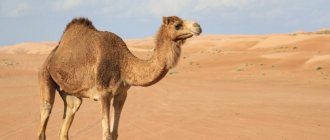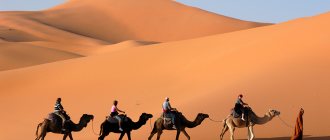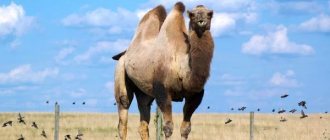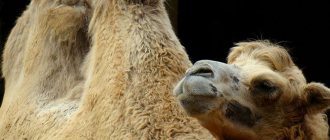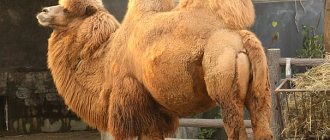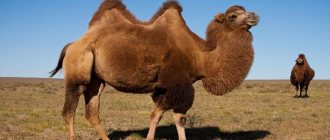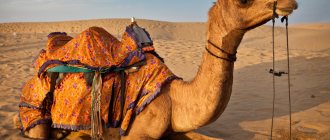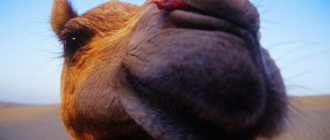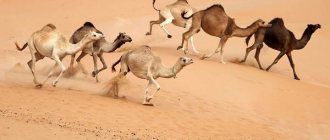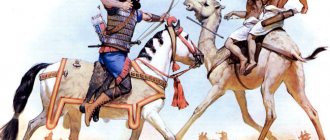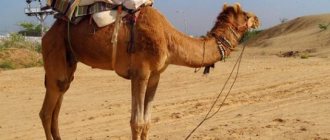Camels: description
Adult camels can have a mass of about 500-800 kilograms, with a height at the withers of slightly more than 2 meters. There are both dromedary camels with a basic reddish-gray color, and Bactrian camels with a basic dark brown color.
Appearance
Camels are characterized by the presence of curly hair, a long and arched neck, as well as small, rounded ears. Representatives of this family are distinguished by the presence of 38 teeth, 10 of which are molars, two are canines, 10 are molars, the next pair are molars, two canines, and another 12 molars.
The camel's eyes are securely closed with long, furry eyelashes, which prevent sand from entering the eyes, and the nostrils are tightly closed with slits if necessary. Camels have excellent eyesight, so the animal can easily see a person a kilometer away, and a moving car 5 kilometers away. This mammal can smell water and vegetation from a great distance.
Interesting to know! Camels sense areas with green spaces located at a distance of 50 kilometers. Seeing thunderclouds in the sky, the animal heads towards them, hoping that it will be able to get into the rain zone.
Due to the presence of special calluses located in the chest area, on the wrists, in the area of the elbow joints, on the knees, the animal is perfectly adapted to conditions when the hot soil heats up to 70 degrees. Thick fur, which is indirect, reliably protects the animal from the scorching sun, as well as low temperatures at night. Wide camel feet are formed by two toes connected to each other. Due to such a common sole, camels easily move on loose sand, as well as on small stone embankments.
Camels are designed in such a way that they practically do not lose fluid through natural feces. Even when breathing, the moisture that is released from the nostrils enters a special fold, after which it again ends up in the animal’s oral cavity. Therefore, camels can go without water for quite a long time, but at the same time they lose almost 40 percent of their total body weight.
Thanks to the presence of humps, which are like peculiar containers with fat deposits, camels manage to survive in such harsh conditions. These humps are like a kind of roof for animals, protecting the mammal’s back from active sunlight. The presence of such fat reserves contributes to high thermal output. Camels are excellent swimmers, and when moving in the water, they tilt their bodies to the side.
Interesting facts about Camel
Character and lifestyle
As a rule, wild camels prefer to lead a sedentary lifestyle, but despite this, animals have to move from one place to another, while they try to stick to already marked areas. The main condition for their normal life is the presence, albeit rare, of bodies of water, which allows animals to replenish their fluid reserves. Basically, camels prefer to move as part of a small herd, which includes several units or dozens of individuals. An experienced male manages such a herd. Such animals display their main activity during the daytime, and when darkness falls, they go to rest. Mostly at night they sleep, but they may not sleep, but they behave rather sluggishly and inactively. When weather conditions worsen, camels do not show activity for several days. When it’s hot outside, they prefer to move against the wind so that body thermoregulation is effectively carried out. On particularly hot days, animals can lie down in bushes or ravines. Wild camels are quite shy and are not known for their friendliness, including towards humans.
Very interesting! Indigenous people practice winter grazing of horses, when they easily stir up the snow cover with their feet, after which camels are driven into such an area. Their task is to select leftover feed.
In case of danger, camels easily run away at a speed of about 60 km/h, while adult individuals can run for several days until they exhaust their energy reserves. According to experts, even unique endurance and considerable size are not able to protect the animal from death. As a rule, this is due to small inclinations of the mind. The lifestyle of tamed camels is radically different from the lifestyle of wild individuals. If a tamed camel is released into its natural environment, it quickly gets used to the lifestyle of its ancestors. Adults, as well as sexually mature males, live independently without any problems. The winter period for camels is quite a serious test, since they are not adapted to move on snow, and since they do not have real hooves, they cannot dig out food from under the snow.
How long do camels live?
If these animals are kept in comfortable conditions, camels can easily live for about 40 years, although this is more typical for domesticated camels. Despite this, among wild individuals there are also long-livers who managed to live for half a century.
Types of camels
There are 2 types of camels:
- Camels are one-humped.
- Bactrian camels.
Currently, dromedary camels are found exclusively in domesticated form, although there may be cases where representatives of this animal species become wild again. They are also called dromedaries, which means “running” in Greek, and also Arabions, which indicates that they were domesticated by the inhabitants of Arabia.
Dromedaries, like Bactrians, have rather long and calloused legs, as well as a more slender build. One-humped camels, compared to two-humped camels, are characterized by smaller sizes. Their body length is no more than 3 and a half meters, with a height at the withers of about 2 meters. One-humped camels weigh an average of 500 kilograms.
Dromedaries have an elongated head, especially the front part, a convex forehead, and a hook-nosed overall profile. The lips, unlike many animals such as horses and cattle, practically do not compress. The cheeks are distinguished by the fact that they are enlarged in size, while the lower lip seems to sag. The neck area of dromedary camels is muscular and well developed.
Interesting fact! The entire upper edge of the cervical region is covered with hair, which gives the appearance of a mane. Long hair grows on the lower part, giving the appearance of a beard. It can reach the middle of the cervical region. The area of the forearms is not covered with hair at all, but the area of the shoulder blades is covered with hair, and the hair is quite long, creating the appearance of “epaulettes”.
One-humped camels, compared to two-humped camels, do not easily tolerate even minor sub-zero temperatures. And yet, dromedaries have fairly dense hair, although it is not thick or long. Therefore, we can safely say that the coat of a dromedary camel has a completely different purpose: it has wool not to warm the body, but to protect the body from loss of moisture.
When it's cold, the body temperature of dromedary camels drops, after which in the sun it begins to rise, although slowly. The longest hair on these camels grows on the head, neck and back. Their main color is sandy, but there are representatives of the species with dark brown, reddish-gray or simply white coat color.
Bactrian camels or Bactrians are the largest representatives of this genus. They are considered the most valuable domestic mammals for most peoples in Asia. They received their name in honor of a certain territory of Central Asia. This territory is called Bactria, and it is characterized by the fact that it was in this area that the domestication of Bactrian camels took place. It is also known that in the wild there are wild Bactrian camels, which are called haptagai. Only a few hundred wild camels live in China and Mongolia. Here they can be found in rather difficult natural conditions, as well as in difficult conditions of the natural landscape.
Bactrian camels look larger than single-humped camels. Adults grow up to 3 and a half meters in length, with a height at the withers of at least 2 meters. The length of the tail is within 60 cm. The weight of adult individuals is at least 500 kilograms. Males fatten up during the summer, so they can weigh up to 800 kilograms; as for females, they weigh less, although only slightly.
The physique of Bactrian camels is quite dense, as are their relatively long limbs. This species of camel is characterized by having a long and curved neck. It has a significant downward deflection, and then rises up again. As a result of this structure of the cervical region, the head is placed at the same level as the shoulder girdle. The two humps are located at an average distance of about 30 cm from one another. A person uses this space as a saddle.
The distance from the bottom of the interhump space to the surface of the earth is about 1 meter 70 centimeters, which makes it difficult for a person to land. Therefore, in order to sit on the back of a camel, the animal kneels or lies on the ground. This space between the humps is never filled with fat, despite the amount of fatness of the animal, as well as its age.
Important point! There are rare individuals that have a lighter coat color. Their weight part is no more than 2.8 percent of the total number of animals of this species.
The fatness and health of a camel are easily determined by the presence of elastic and evenly standing humps. If an animal has lost significant weight, then its humps fall to the side either completely or partially, and when the animal walks they dangle from side to side. Bactrian camels, compared to single-humped camels, have fairly dense and thick hair, and the presence of undercoat is noted. This allows the animal to feel comfortable in conditions where summers are quite hot and winters are cold and snowy.
Thanks to this structure of the coat, animals can easily tolerate cold temperatures down to minus 40 degrees. The structure of the wool has internal cavities, which significantly reduces the thermal conductivity of the wool. A well-developed undercoat does not allow air to penetrate the animal’s skin. The thickness of the coat of bacteria reaches 6 cm on average, while the lower part of the cervical region, as well as the tops of the humps, are covered with wool, the length of which is about 25 centimeters. As a rule, such long hair appears in animals in the autumn, before the onset of winter cold. With the onset of spring, Bactrian camels begin to shed and the hair can fall out in large fragments, so the camels look unkempt and unkempt.
The main color of Bactrian camels is brown-sand, while the intensity of the color can be different, so there are individuals that are either very dark or very light, sometimes of a reddish tint.
CAMELS. 10 interesting facts about them, buy a camel
Appearance and features
Amazing animals, unlike the well-known Bactrians, are endowed with only one hump, which is why they got their name. Comparing 2 subspecies of one main species of camels themselves, the distinctive external features of dromedaries, in addition to the presence of one hump instead of two, are visible to the naked eye:
- Significantly smaller sizes. The dromedary camel has smaller height and weight parameters in comparison with its closest relative. Its weight varies from 300 to 600 kg (the average weight of a male is 500 kg), height - from 2 to 3 meters, and length - from 2 to 3.5 m. The same parameters for Bactrians have significantly higher indicators.
- Tail and legs. The dromedar has a shorter tail, the length of which does not exceed 50 cm. Its physique is much more graceful, but its legs are longer than those of its brother. Thanks to these characteristics, the dromedary camel is characterized by greater maneuverability and speed of movement.
- Neck and head. This subspecies has a long neck and an elongated elliptical head. In addition to the forked lip, the dromedary is endowed with another feature - nostrils, the opening and closing of which it controls independently. The dromedary camel has long eyelashes that can protect the eyes from even the smallest grains of sand.
- Features of the structure of the legs. In addition to the fact that the legs of this subspecies of camels are longer, they are also covered with special callous growths in places where they bend. The same growths cover numerous parts of the body. Another distinctive feature of dromedary camels is the soft, calloused pads on the feet, which replace the hooves, in place of which there is a pair of toes.
- Wool cover. This species is known for its short hair, which makes it categorically unadapted to cold climates. However, the coat in certain areas of the body is longer and thicker: on the neck, back and top of the head. The color of dromedary camels ranges from light brown, sand to dark brown, and even white. Although albino dromedaries are extremely rare.
Just like Bactrian camels, this subspecies is particularly resilient in arid climates. This is due to the fact that dranomedas are able to retain moisture and have a hump, which contains a large amount of fat. This fact contributes to the rapid compensation of resources, providing the animal’s body with the necessary energy.
Where do camels live
Camels are animals that live in dry steppes and desert areas. They are in no way adapted for life in other natural conditions, including mountainous areas. Camels, especially domesticated ones, are currently found across the vast expanses of the Asian and African continents.
Dromedaries are found even in northern Africa, including one degree south latitude, as well as in Central Asia and the vast expanses of the Arabian Peninsula. Camels appeared in Australia in the 19th century after they were brought there by humans. Oddly enough, these animals have taken root on the Australian continent and today the population of camels in Australia reaches 50 thousand individuals.
Interesting to know! Bactrian camels are inhabitants of territories adjacent to Asia Minor and extending to Manchuria. In total, there are about 19 million individuals in the world, with 14 million individuals living within the African continent.
About 7 million camels live in Somalia, and about 3 million or a little more live within Sudan. Dromedary camels living in the wild became extinct at the beginning of our era. It is believed that they mainly inhabited the southern territories of the Arabian Peninsula. Scientists have never been able to establish the real ancestors of dromedary camels: either they were wild forms of dromedary camels, or they have common ancestors with Bactrian camels.
Przhevalsky first learned that wild Bactrian camels also existed during an Asian expedition. At that time, their existence was simply assumed, but no one could confirm this fact before Przhevalsky.
Today, wild haptagai camels live exclusively within the Xinjiang Uygur Autonomous Region, as well as in Mongolia. The total number of wild animals of this species is determined to be somewhere within 1 thousand individuals, which unites 3 separate populations. Nowadays, the issue of bringing Bactrian camels to the conditions of Yakutia is being considered.
Where does the dromedary camel live?
This subspecies is extremely hardy and adapted to severe droughts. This is primarily due to its physiological characteristics. That is why the habitat of dromedaries is the North African regions, the Middle East, Turkestan, Asia Minor and Central Asia, Iran, and Pakistan.
The endurance of dromedary camels is dictated by several specific functions of their body:
- the moisture that the animal needs to retain for survival is stored not in the hump, but in the stomach;
- the functions of the kidneys of this subtype are tuned to maximum dehydration of excreted urine, thereby preserving moisture;
- animal hair prevents moisture evaporation;
- the work of the sweat glands is also different from other mammals (body temperature decreases at night and remains within normal limits for a long time). Sweat begins to be released only at a temperature of +40℃ and above;
- Dromedars have the ability to quickly replenish the reserves of necessary fluid and are able to drink from 50 to 100 liters of water at a time within a few minutes.
It is thanks to these features that the dromedary camel is indispensable for the Arab peoples living in desert areas. Its special characteristics are used not only in moving heavy objects and people, but also in agriculture.
What does a camel eat?
Camels are the most common representatives of ruminants. Both species eat plants such as saltwort and wormwood, camel thorn and saxaul. Camels can even drink salt water without problems, while all the liquid of such animals is stored in the cellular parts of the stomach. Dehydration of such animals is not a terrible problem, since fat serves as the basis for them to obtain life-giving moisture. In the process of oxidation of one hundred grams of fat, about 107 g of water and carbon dioxide are obtained.
Important fact! Wild camels are so cautious and mistrustful that they would sooner die from lack of water and food than approach a person.
When these animals cannot replenish their body with water for a long time, their blood never thickens. These animals can live without water for about 2 weeks, and in the absence of food - about 1 month. And yet they have to suffer greatly from the fact that the number of watering places is noticeably reduced in our time. This is mainly due to human activity, which is increasingly developing desert territories.
Why are camels needed? Breeding and keeping camels. Breeding plant Kirovsky.
Nutrition
In terms of food, camels are completely unpretentious, because in the desert it is extremely rare to find the kind of food that wild animals primarily feed on. Camels are accustomed to eating plants of different shapes and colors, and can also go for several days without food at all.
Camels can eat the following types of plants:
- saxaul – branches;
- fresh and dry, burnt grass;
- barnyard;
- poplar leaves;
- sagebrush;
- camel-thorn;
- bushes.
Camels are able to digest even completely inedible food - for example, thorns. In addition, their digestive system processes incoming substances and releases nutritious fiber.
Animals begin to consume poplar leaves and reeds when cold weather sets in. In rare cases, when it gets too cold, Bactrians can eat not only plant food, but also the skins of dead animals.
Camels are also unpretentious in relation to water. For more than a week, the animal does not need to replenish its fluid reserves, provided that it eats fresh grass. But when a spring comes across the way, the camel absorbs a huge amount of liquid - up to 130 liters of water. Domestic camels look for fresh water, but wild khaptagai can even get by with the liquid they get from brackish water bodies.
The animal's diet may vary depending on where it lives. Animals domesticated by people, in addition to plant foods, began to eat some types of vegetables and fruits, as well as silage and grain.
The digestive system of camels is well developed and processes even the coarsest food. All food is swallowed whole, half digested, and then spat out, after which the camel begins chewing. The camel spits not so much saliva as particles of digested chewing gum.
It is believed that dromedaries are more picky eaters - they can only eat plant foods, while Bactrian camels eat animal skins and bones in cold periods.
Hunger is not a problem for these animals. During such periods, the survival rate of animals even increases. For an adult animal, the normal period for fasting is about 30 days. All this time, his body receives nutrients from reserves deposited in the humps.
Reproduction and offspring
Around the age of 3 years, camels begin their reproductive period. A female dromedary camel carries her offspring for 13 months, and a female Bactrian camel carries her offspring for 1 month longer. This process is very typical, as for most artiodactyls.
The breeding process of camels is accompanied by very aggressive behavior of males, which is extremely dangerous both for humans and for the males themselves. In the fight for the right to fertilize females, males stage brutal fights, using both their limbs and teeth in the fight. As a result of such battles, males receive multiple injuries, sometimes incompatible with life. During this period, they are capable of attacking even humans.
This process occurs in winter, when the rainy season begins, which can provide these mammals with sufficient moisture. In dromedary camels, the reproductive process begins a little earlier. Mostly, only one baby camel is born, although sometimes a pair of cubs is possible. After birth, the baby camel quickly gets to its feet and goes with its mother in search of adventure.
Important point! During fights, sexually mature males try to knock down their opponent, after which they try to trample the one who has fallen to the ground.
Since adult one-humped and two-humped camels differ in size, camels also differ in both size and weight. Cubs feed on their mother's milk until the age of 6-18 months, regardless of the variety. Parents' care for their offspring continues until the offspring are ready to reproduce.
Features of character and lifestyle
Camels are rather slow animals. The peculiarity of their behavior is that they live according to a clear daily routine, without deviating from it. This is what allows them to retain energy and moisture longer. Despite their sedentary behavior, the subspecies is able to travel long distances every day. Our ancient Slavic ancestors endowed the word “camel” with the meaning “long wandering.”
Dromedaries search for food in the morning and evening hours, and during the day and at night they rest in the open spaces of sand dunes. Dromedary camels move at an average speed of around 10 km/h, but, if necessary, they can start running (no more than 30 km/h). Such speed is possible, but a camel is not capable of galloping for a long time.
Another distinctive feature of them is their extremely good eyesight, because they are able to see approaching danger from very long distances. As soon as, for example, a person comes into the camel’s field of vision, he leaves long before he gets close. In everyday life, a flock of dromedaries is calm - individuals do not conflict with each other. But during the rutting period, males are capable of showing aggression towards other males, fighting for mating with one or another female. During this period, dromedary camels are able to engage in fights and mark their territory, warning enemies of their leadership. In Turkey, the period of aggressiveness of camels is used for camel fights, traditional in this territory. Despite all the passivity of their main character traits, camels are endowed with high intelligence and a unique character.
In some matters, dromedaries are quite whimsical:
- Females of this subspecies allow themselves to be milked exclusively by a specific person. At this moment, the female’s cub must certainly be in her field of vision.
- Adults demand respectful treatment, not forgiving insults or cruel treatment.
- If the dromedary has not rested or is in a state of sleep, then it cannot be forced to rise to its feet.
- The memory of all representatives of the subspecies is developed in an amazing way - they are able to remember an insult for many years and will certainly take revenge on the offender.
- Dromedaries become attached to a person, and in case of separation, they are able to independently find their way to the owner.
In general, dromedaries are endowed with an imperturbable calmness, friendliness and the ability to quickly adapt to a particular habitat, which makes them excellent helpers for humans. Even in the wild, they do not attack people, but only avoid meeting them.
Natural enemies
Modern camels are very lucky because they are deprived of such a predator as a tiger, but in the past tigers hunted not only wild but also domesticated camels. This was possible within Lake Lob Nor, but after irrigation work, tigers disappeared from these areas. Despite their very large size, Bactrian camels were absolutely defenseless, especially if they found themselves in the quagmire of salt marshes. Tigers attacked domesticated camels no less often, so people tried to constantly pursue this predator. This was typical for many camel-breeding areas.
Important point! Various diseases, and there are many of them, have a serious impact on the camel population.
A dangerous natural enemy of camels is the wolf, which annually reduces the number of such animals. Moreover, this is typical for both wild and domestic animals. In addition, camels are quite fearful animals that do not know how to stand up for themselves. When wolves attack, camels only spit and scream loudly. Crows can also peck at wounds on the body of these animals, which indicates the complete defenselessness of camels.
Population and species status
If wild one-humped camels became extinct in prehistoric times, then the two-humped camels did not suffer a similar fate, and they exist on our Planet in a wild form.
Important fact! Nowadays, there are not many wild Bactrian camels left, so they are listed in the International Red Book. They are classified as CR, which corresponds to a species that is on the verge of extinction.
For the sake of fairness, it should be clarified that wild Bactrian camels became rare at the beginning of the last century. If we talk about the current time, then their existence is under threat. The degree of threat is so high that wild camels rank eighth among all animals on our Planet that are on the verge of extinction.
Natural enemies of the dromedary camel
One-humped camels, despite their compact size compared to Bactrians, are quite large animals. In desert regions there are no individuals capable of exceeding their size, and therefore they simply cannot have enemies in their natural habitat. However, frequent cases of wolf attacks on dromedary babies have been recorded. In the past, this subspecies had other enemies (separate subspecies of desert lions and tigers), but today these animals are considered completely extinct.
Camels, both dromedaries and Bactrians, have one common enemy: humanity. Due to mass domestication more than 3 thousand years ago, the original wild herds of dromedary camels did not survive in natural conditions (they were only re-wilded in the central part of the continent of Australia). Their cousins, the Bactrians, are still found in the wild, but their populations are so small that they are also endangered and listed in the Red Book.
The massive rush of people to domesticate dromedaries is not surprising. In addition to being an excellent means of transportation and cargo transportation, their fur, meat and milk have incredible qualities. Camel skins are famous for their thermal insulation, meat for its distinctive taste, fat is similar to lamb, and milk is famous for its fat content and content of beneficial microelements.
Camels and man
Camels have been domesticated by humans for a long time, so some Asian peoples use them in their daily lives as an assistant. In addition, as a result of crossing different types of camels, hybrids with different characteristics were obtained. The following hybrids are of interest:
- “ Nar ” is a fairly large animal, weighing almost 1 thousand kilograms. The hybrid appeared as a result of crossing the one-humped Arvan camel with the two-humped Kazakh camel. This hybrid is distinguished by the presence of one, but large hump, as if consisting of 2 humps. The bunks have one very important characteristic, thanks to which people continue to breed this hybrid - decent milking qualities. Every year it is possible to obtain up to 2 thousand liters of milk from one individual.
- “ Kama ” is considered a very popular hybrid, which was obtained by crossing a Bactrian camel with a llama. The animal is small in height, only 120-140 cm, and also light in weight, around 70 kilograms. These animals do not have a hump as such, but kamas are distinguished by their unique endurance. This allows the hybrid to be used as a beast of burden, especially in difficult natural conditions.
- " Iners " or " Iners " is a single-humped hybrid distinguished by its impressive size as well as excellent coat characteristics. The hybrid was obtained by crossing a male Arwan with a female Turkmen camel.
- " Jarbay " is not widely used and is therefore considered a very rare hybrid. The animal was obtained by crossing two hybrids.
- " Kurt " is a single-humped hybrid, which is also not so popular. It is obtained by crossing a female Inera with a male Turkmen camel. Despite the fact that the animal produces a lot of milk, its fat content is quite low.
- " Kaspak ". This hybrid was obtained by crossing a male Bactrian camel with a female Nara. The hybrid is very popular as it produces a lot of milk and a lot of meat.
- “ Kez-nar ” is a very common hybrid form obtained by crossing a kaspak with a Turkmen camel. This is a large animal that produces a record amount of milk.
Man actively uses not only camel milk, but also the meat and fat of these animals. In addition, the wool of these animals is highly valued, since incredibly warm clothes, blankets, shoes and other things necessary for people are made from it.
the camel bit off his hand
Interesting Facts:
- The name "dromedary" is of Greek origin and translates as "running". The name "Arabian" comes from the word Arabia, where this variety of camel was domesticated.
- During severe droughts, a dromedary camel can lose up to 25% of its weight without dying from hunger or thirst. In particular, the dorsal hump with its fat reserve helps him in this, and the camel’s entire body effectively accumulates water and prevents it from quickly evaporating with sweat.
- The exact dating of the process of domestication of the dromedary camel has not yet been established, but it occurred on the Arabian Peninsula around the third millennium BC. Camel riders are first mentioned in an Assyrian obelisk with a list of those who took part in the Battle of Karkar in 853 BC. e., and where 1000 Arab camel riders are indicated. Their images can be found on reliefs in Nimrud during the era of Ashurbanipal. As a domestic animal, dromedaries spread quite late, approximately in the second half of the first millennium BC. Today, various breeds of dromedary camel have been developed, adapted to different functions. There are camels that are used for transporting goods, riding, racing, mountain and lowland camels, as well as transitional forms.
- Today, dromedary camels are widely used as pack animals (they are capable of carrying up to 150 kg of cargo) and riding animals, and in the semi-deserts of northwestern Africa and central Asia and the Arabian Peninsula, they are a valuable source of products such as milk for local residents , meat and wool.
- In many countries of Asia and Africa, and also in Australia, dromedary camel racing is very popular today; sometimes special racing dromedaries are even bred for this purpose.
